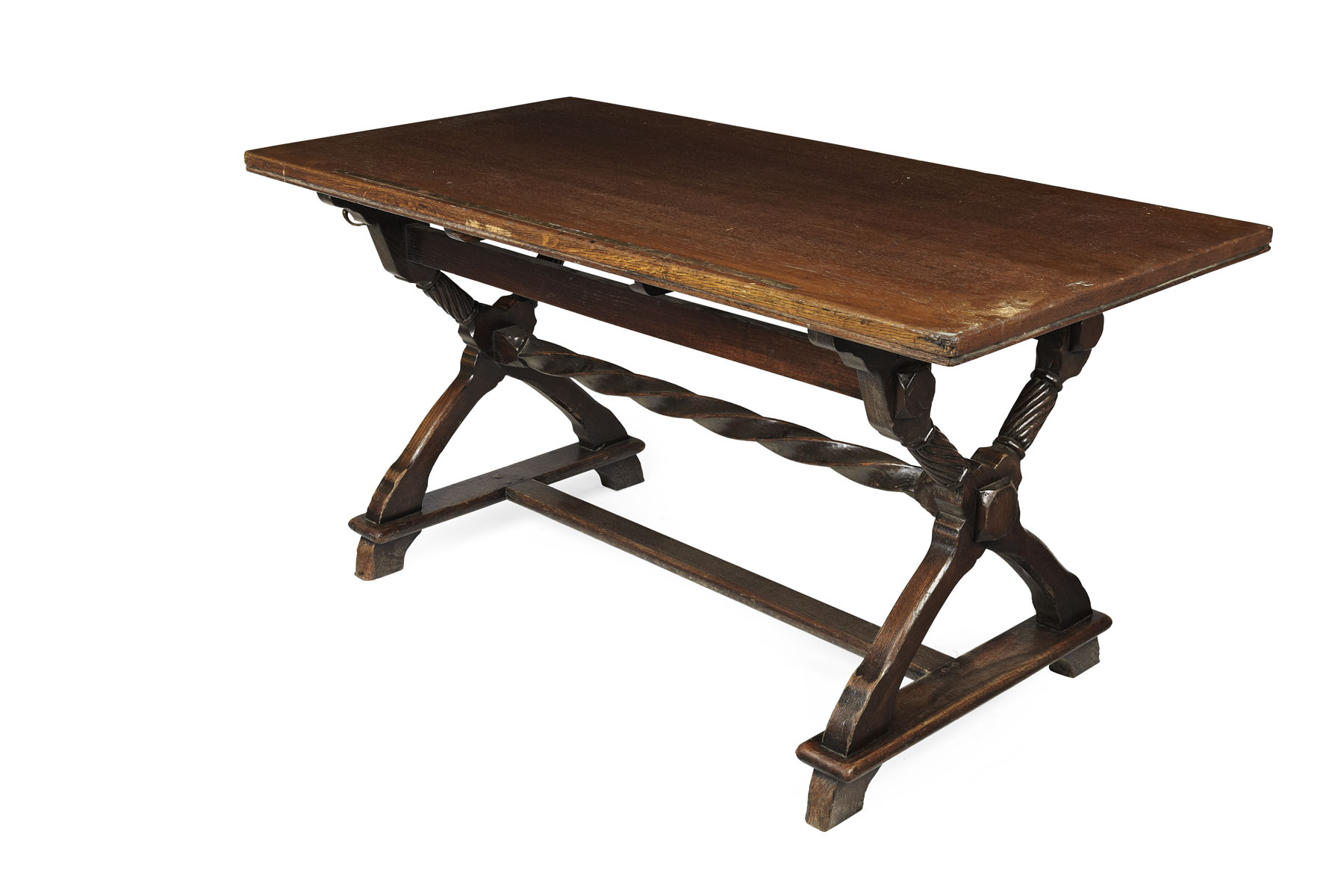
Lot 341

LIBERTY & CO., LONDON
FUMED OAK CENTRE TABLE, CIRCA 1924


Auction: 9 March 2011 at 11:00 GMT
Description
the rectangular top with moulded edge, later inset with brass yard rule, above cross framed supports, each with spirally reeded elements linked by a spirally fluted central stretcher and with twin planked stretchers above, the platform base raised on bracket feet and linked by a plank stretcher, drawer lacking, stamped mark '6961', later label '615'
Dimensions
152cm long, 76cm high, 68cm wide
Footnote
Provenance: Liberty & Co. London
Literature: Calloway, Stephen 'The House of Liberty', London 1992
Note: This lot forms part of a collection of Arts & Crafts furniture made in the early 1920s for Liberty & Co's magnificent Tudor building in Great Marlborough Street. The building was completed in 1924 and was built so that trading could continue while renovations were being completed on their adjacent premises in Regent Street. It was designed by Edwin Thomas Hall and his son Edwin Stanley Hall at the height of the 1920s fashion for the Tudor revival and constructed from the timbers of two 19th century men-of-war battleships: HMS Impregnable and HMS Hindustan. After the First World War a more reactionary attitude towards architecture and design was understandable and the Liberty board recognized the marketing advantage and reassurance to their customers of building in the sixteenth century manner. The new building would demonstrate craft of the highest quality and attention to detail and would be a reflection of the Arts & Crafts values of "truth to material" which had played such an important part in the foundation of the company and the goods that it sold.
The shop was engineered around three galleried light wells that formed the main focus of the building and emulated the great atrium spaces of Bon Marché and Printemps in Paris. Sir Arthur Liberty, who founded Liberty & Co. in 1875, wanted to create the feeling that you were walking around your own home so surrounding these wells were more intimate rooms which reflected the warren of rooms found in the original shop in Regent Street. Liberty's own workshops in Highgate made the wood panelling and a team of twenty carvers worked for eighteen months on the woodwork alone.
Under the supervision of the architects a collection of furniture was made for the rooms and galleries to display the textiles, clothes and luxury goods the shop was so famous for. It is represented by a series of tables, chests and display cabinets, all made in the sixteenth century style, with pegged construction and decorative details complimenting the design details in the building. The finish is either a dark fumed, natural or limed finish, also a characteristic of the wood finishes of the rooms in which they once stood. The first group is designed in a Tudor style, with substantial oak planked tops above pegged supports pieced with decorative panels, also seen on paneling and staircases in the main shop (figure 2). The second group also displays a 16th century aesthetic, with identical planked tops raised above cross framed supports. The chests of drawers and the magnificent hexagonal centre table have distinctive hand wrought iron handles and linenfold panelling, found in other furniture still in situ. All the furniture was made in the firm's workshops in Highgate and demonstrates the same high levels of craftsmanship and attention to detail as the building itself. A photograph of the workshop in the 1920s (figure 3) shows a chest of drawers and a display cabinet being produced.
Liberty & Co. has retained a core of pieces for its collection; however a substantial selection of this historic furniture, now unsuitable for contemporary retailing, is offered here. Lyon & Turnbull will sell the furniture designed by Sir Robert Lorimer as part of their sale of Scottish Design on June 15th, 2011.

